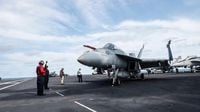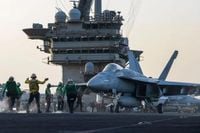For the second time in just over a week, a U.S. Navy fighter jet from the USS Harry S. Truman aircraft carrier has been lost in the Red Sea, raising concerns over the safety of operations involving the carrier. On May 6, 2025, an F/A-18F Super Hornet was attempting to land on the carrier when its arrestment system failed, causing the aircraft to plunge into the sea. Fortunately, both pilots aboard the jet ejected safely and were rescued with minor injuries.
The incident occurred around 9:45 p.m. local time as the USS Harry S. Truman was maneuvering, reportedly to position itself against threats from Houthi militants in Yemen. This mishap follows closely on the heels of another incident on April 28, when a similar F/A-18E Super Hornet fell overboard while being towed in the hangar bay. In that event, a sailor sustained minor injuries, and a tow tractor was also lost to the sea.
The F/A-18 fighter jets involved in these incidents are valued at approximately $67 million each, making their loss significant not just in terms of operational capability but also in financial terms. The U.S. Navy has stated that investigations are ongoing into both incidents to determine the exact causes and to prevent future occurrences.
In addition to these recent losses, the USS Harry S. Truman has faced other operational challenges during its deployment in the Middle East. In February 2025, the carrier collided with a merchant vessel near Port Said, Egypt, causing damage to both ships. Furthermore, in December 2024, an F/A-18 operating from the Truman was mistakenly shot down by the USS Gettysburg, a guided missile cruiser that was accompanying the carrier at the time. Fortunately, both pilots from that incident were successfully recovered.
The backdrop to these incidents is the ongoing conflict involving the Iran-backed Houthi rebels, who have been actively targeting commercial and military vessels in the Red Sea for over a year. This escalation began in late 2023 when the Houthis claimed solidarity with Palestinians amid the Gaza conflict. The U.S. military has been engaged in counter-strikes against the Houthis since mid-March 2025, leading to the loss of seven MQ-9 Reaper drones in the Yemen area since March 15, 2025.
On the same day as the latest jet incident, President Donald Trump announced a ceasefire deal with the Houthis, stating that the U.S. would halt its airstrikes if the group agreed to stop their attacks on American vessels. "They say they will not be blowing up ships anymore," Trump said, indicating a potential shift in U.S. military strategy in the region. This ceasefire agreement follows extensive military operations that have cost the U.S. over $1 billion and involved strikes on more than 800 targets in Yemen.
The USS Harry S. Truman, which is typically stationed at Naval Station Norfolk in Virginia, has been deployed in the Red Sea for several months as part of a broader strategy to counter threats to shipping and maintain stability in the region. The carrier is one of two U.S. aircraft carriers currently operating in the Middle East, highlighting the importance of naval power in U.S. foreign policy.
As investigations into the recent jet incidents continue, the Navy is under scrutiny to ensure the safety and effectiveness of its operations. The loss of valuable aircraft and the risks faced by pilots underscore the complexities of military engagements in volatile regions.
While the recent incidents have raised questions about the operational safety of the Truman and its air wing, the U.S. military remains committed to its mission in the region. The ongoing conflict with the Houthis and the recent ceasefire agreement may shape future military actions and operational protocols.
In the aftermath of these events, the U.S. Navy is expected to review its procedures for landing and towing aircraft to prevent similar incidents in the future. The safety of personnel and the preservation of military assets remain top priorities as the Navy navigates the challenges of modern warfare.
As the situation develops, the implications of these incidents will likely resonate beyond the immediate context, affecting U.S. military strategy and relations in the Middle East.


